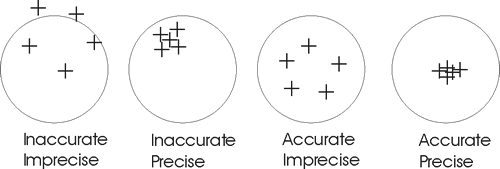1. Units: ALWAYS report units when recording data and writing reports.
2. Significant figures:
Rule 1: always record data to the proper number of significant figures
Zeros:
leading zeros—-never significant. (e.g. 0.0000000001)
captive zeros—-always significant. (e.g. 1.0000000001)
trailing zeros—-significant only if the number contains a decimal point.
1000000000 (?) 1.0000000000 x 109 (11 sig. figs.)
1.0000 x 109 (5 sig. figs.)
1.0 x 109 (2 sig. figs.)
Rule 2: When numbers are multiplied or divided, the number of significant figures in the product or quotient cannot exceed that of the least precise number used in the calculation.
e.g. 1.0034 g x 2.0 g = 2.0068 g (calculation) = 2.0 g (report)
Rule 3: In addition and subtraction, the sum or the difference cannot be stated to more places after the decimal than the term with the least number of places after the decimal.
1.0 liter
+ 0.001 liter
1.0 liter
3. Rounding off numbers:
a. When the insignificant figure is less than halfway, round down.
b. When the insignificant figure is more than halfway, round up.
c. When the number is exactly halfway: round to the nearest even digit.
Examples:
43.550 43.6 (round to the nearest even number 6)
43.450 43.4 (the number before 5 is a even number already)
43.4501 43.5 (the number 501 is greater than halfway)
4. Accuracy and Precision:
